Framing the Residential Patterns of Asian Communities in Three Italian Cities: Evidence from Milan, Rome, and Naples
Abstract
:1. Introduction
2. Materials and Methods
2.1. Population Data and Geographical Areas of Interest
2.2. Homogenising Geographies
2.3. Measuring Residential Segregation
3. Results
4. Discussion and Conclusions
Author Contributions
Funding
Informed Consent Statement
Data Availability Statement
Conflicts of Interest
Appendix A
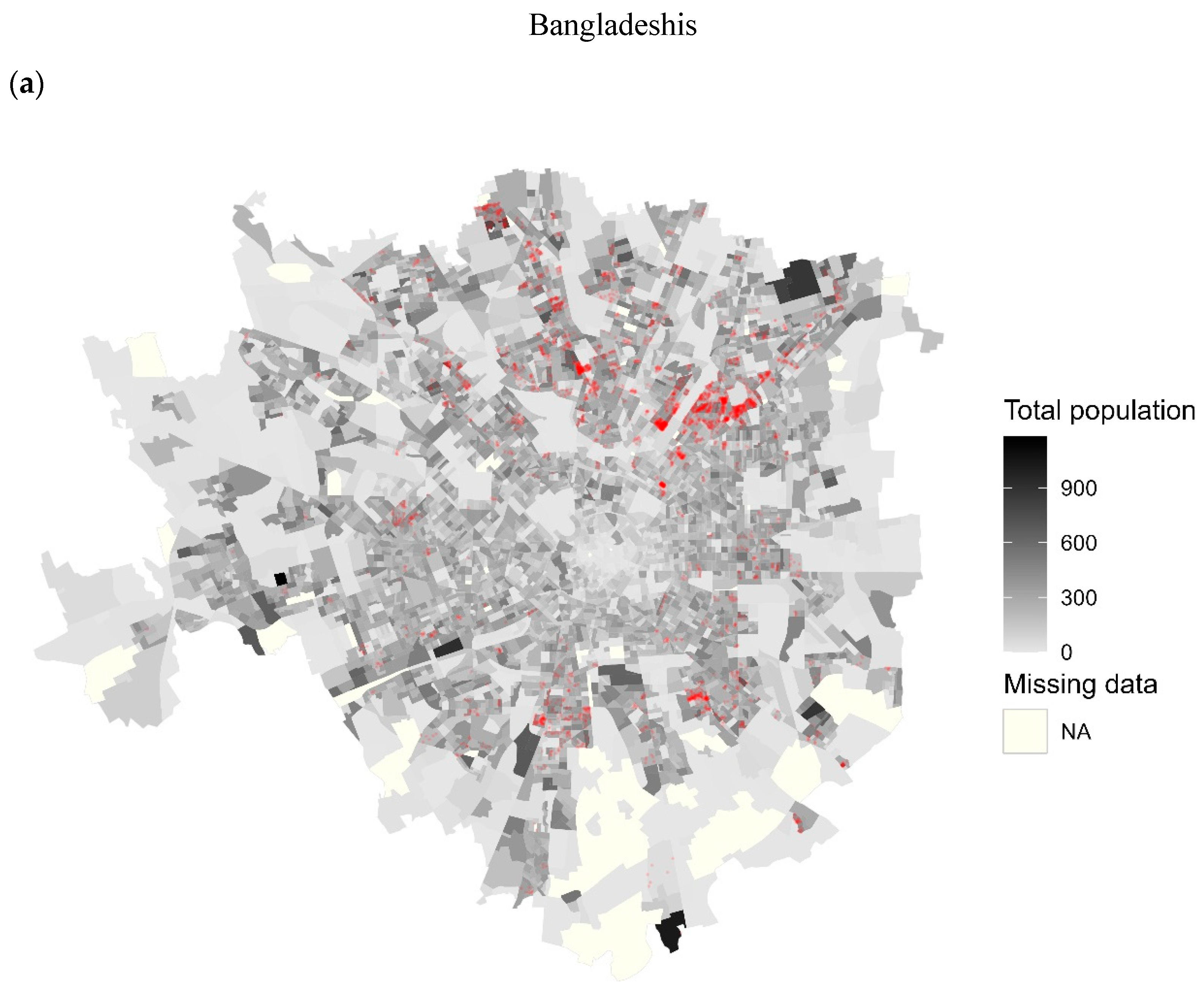


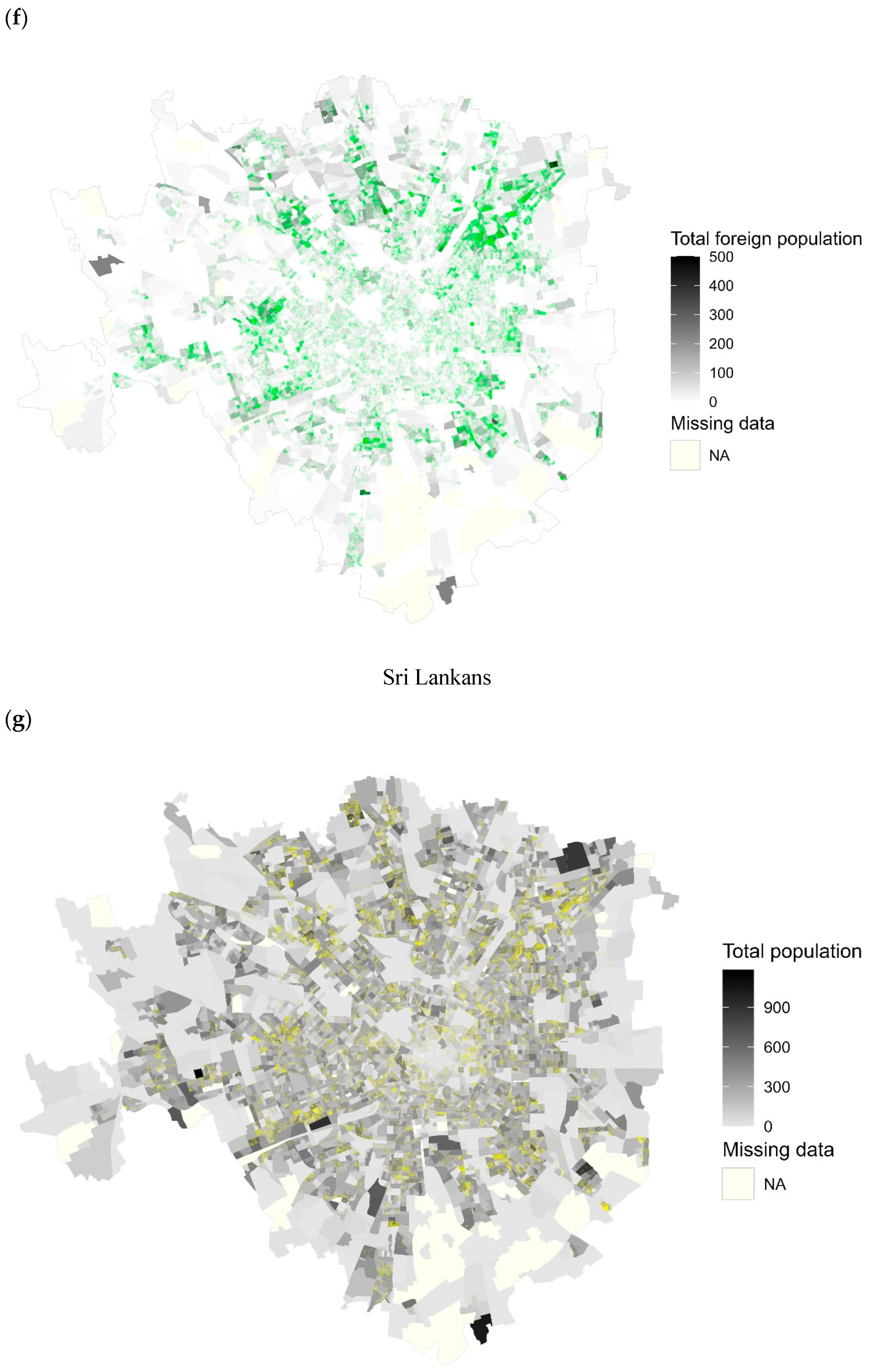
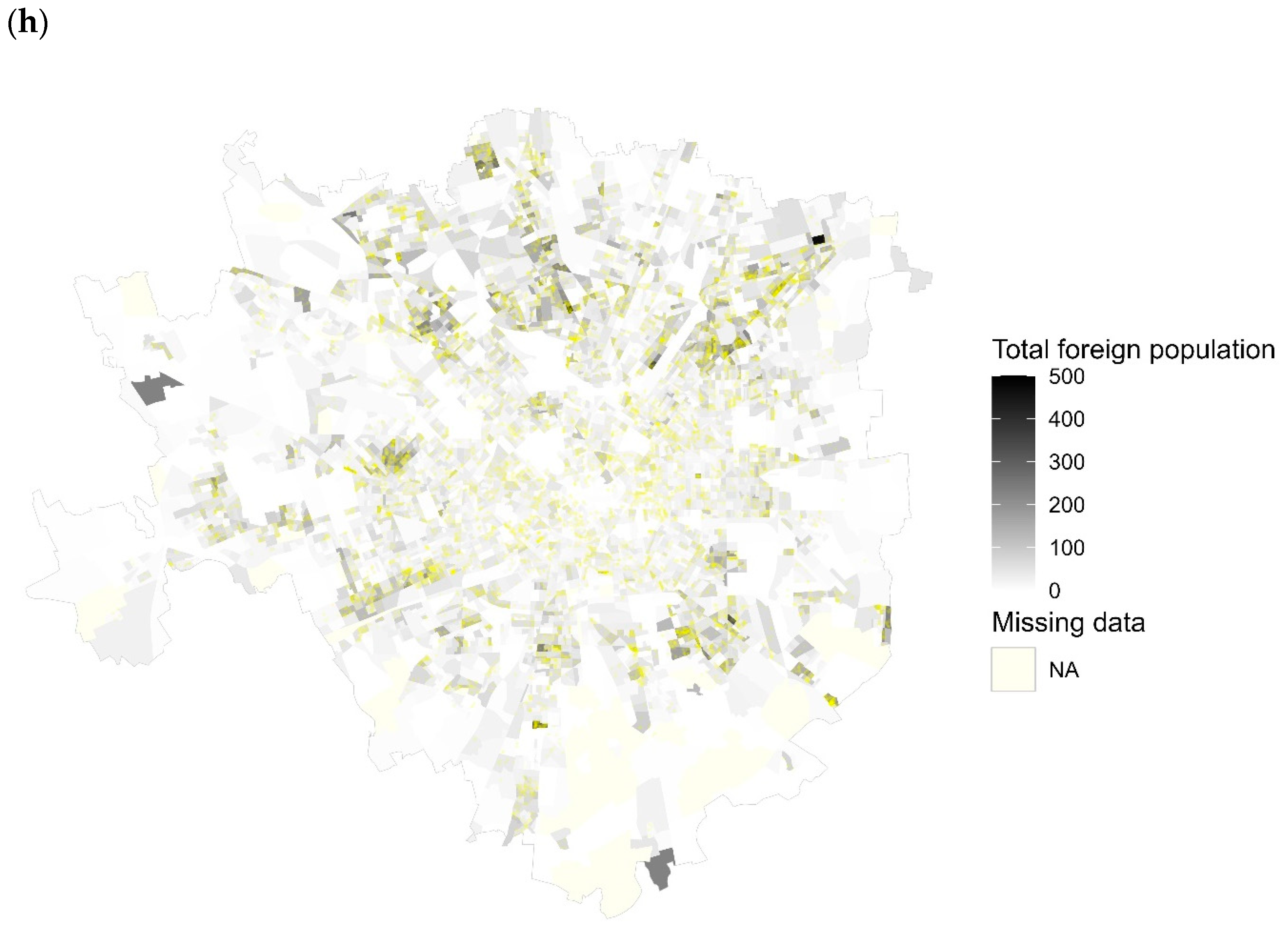

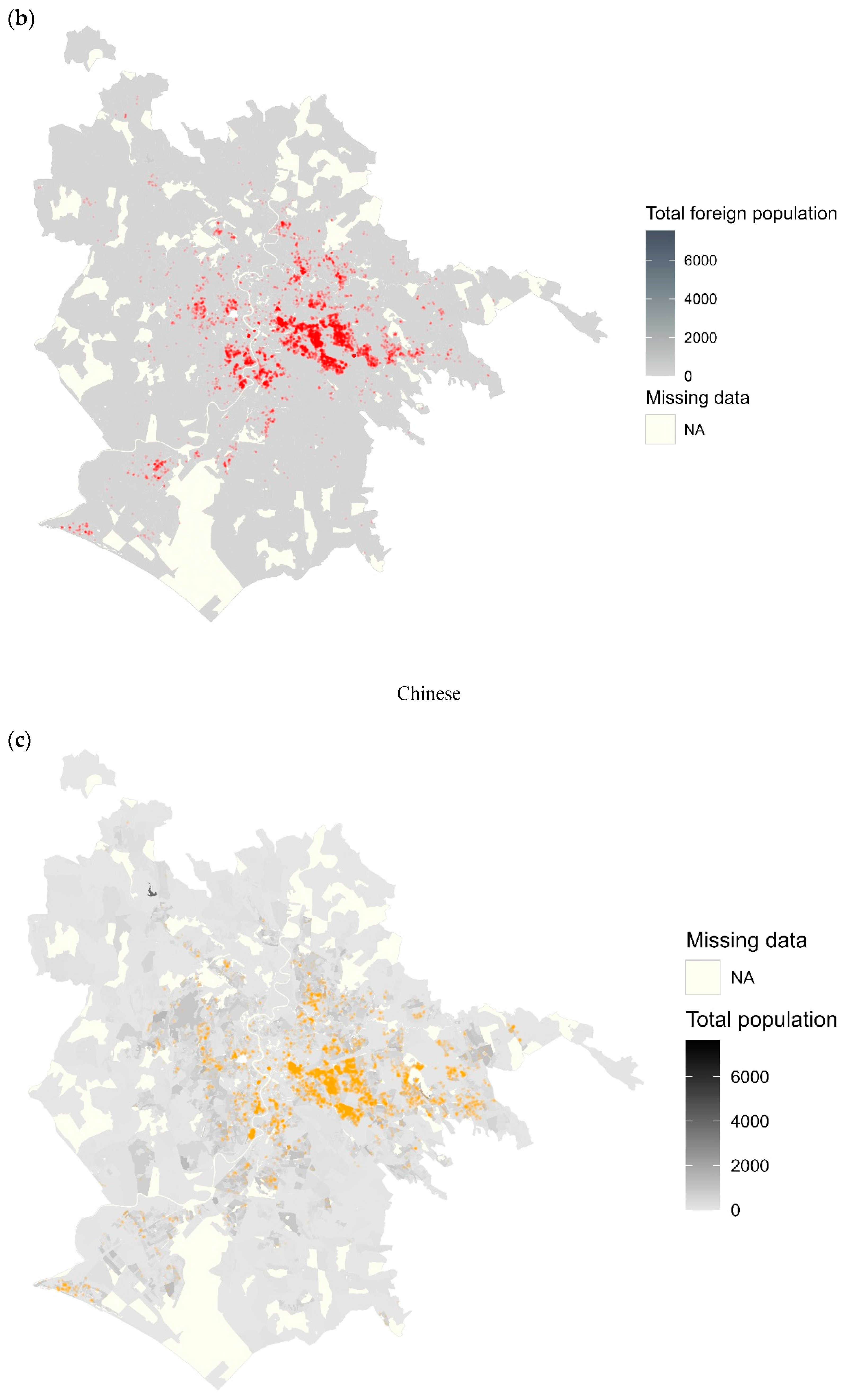
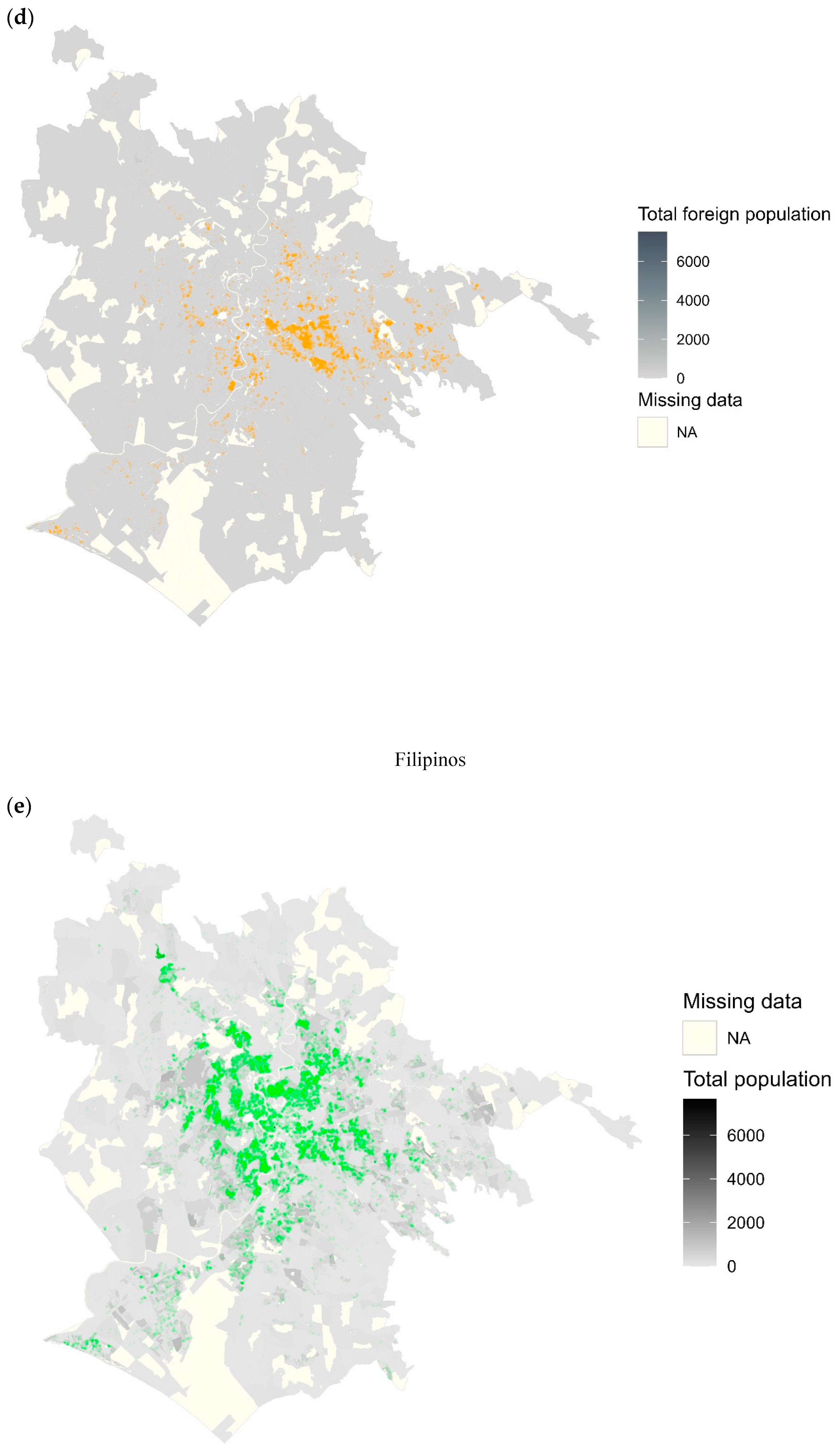

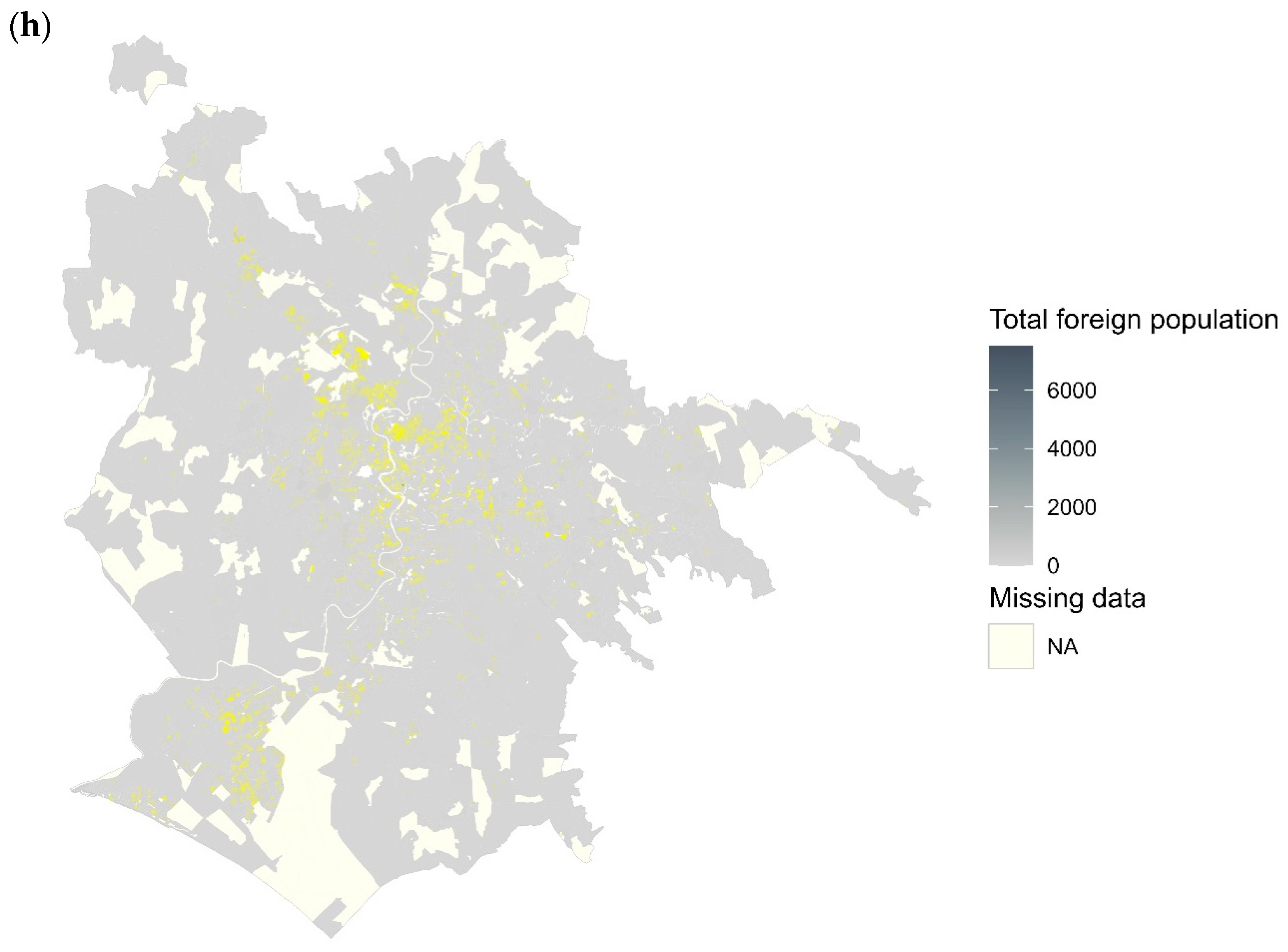
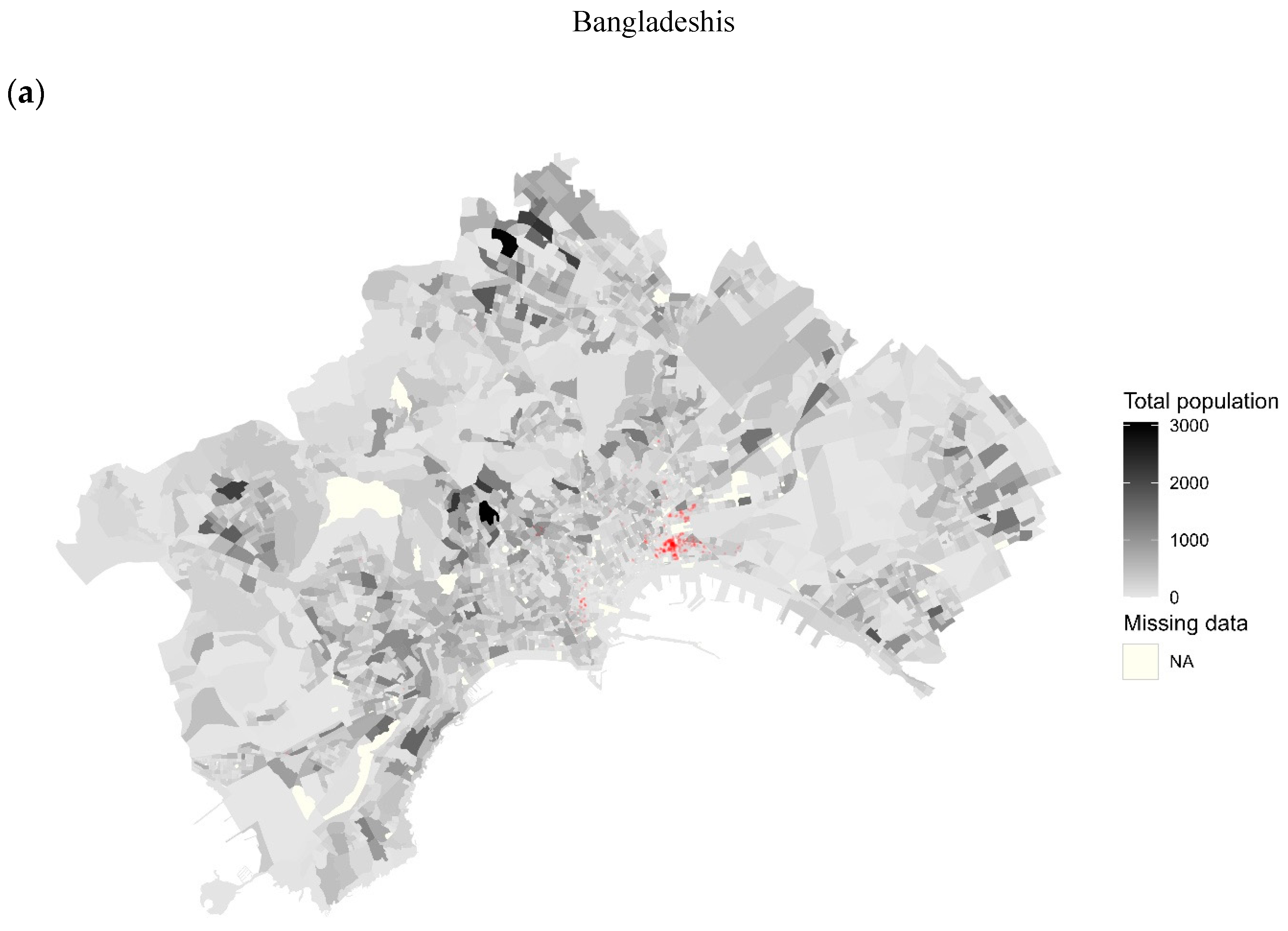

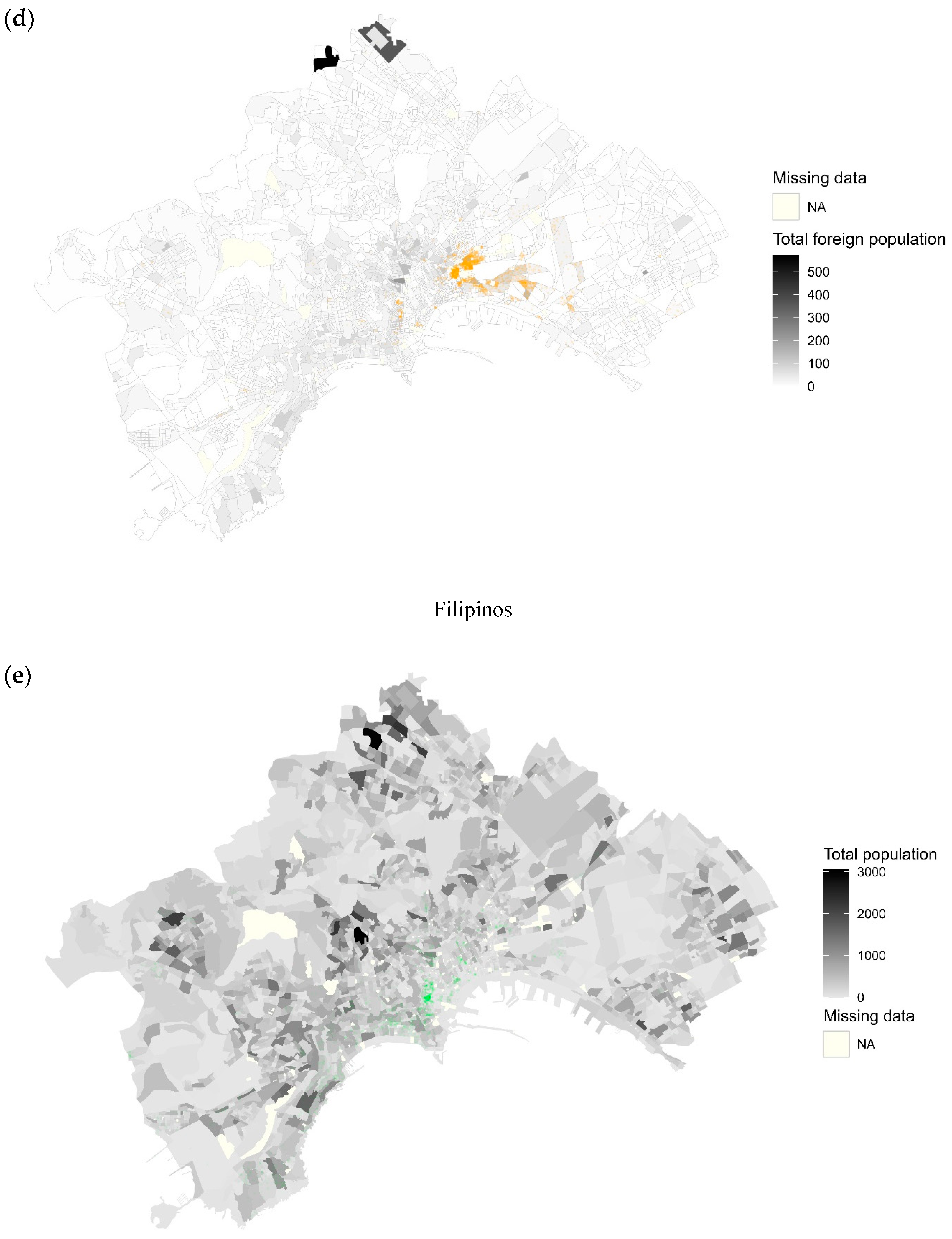
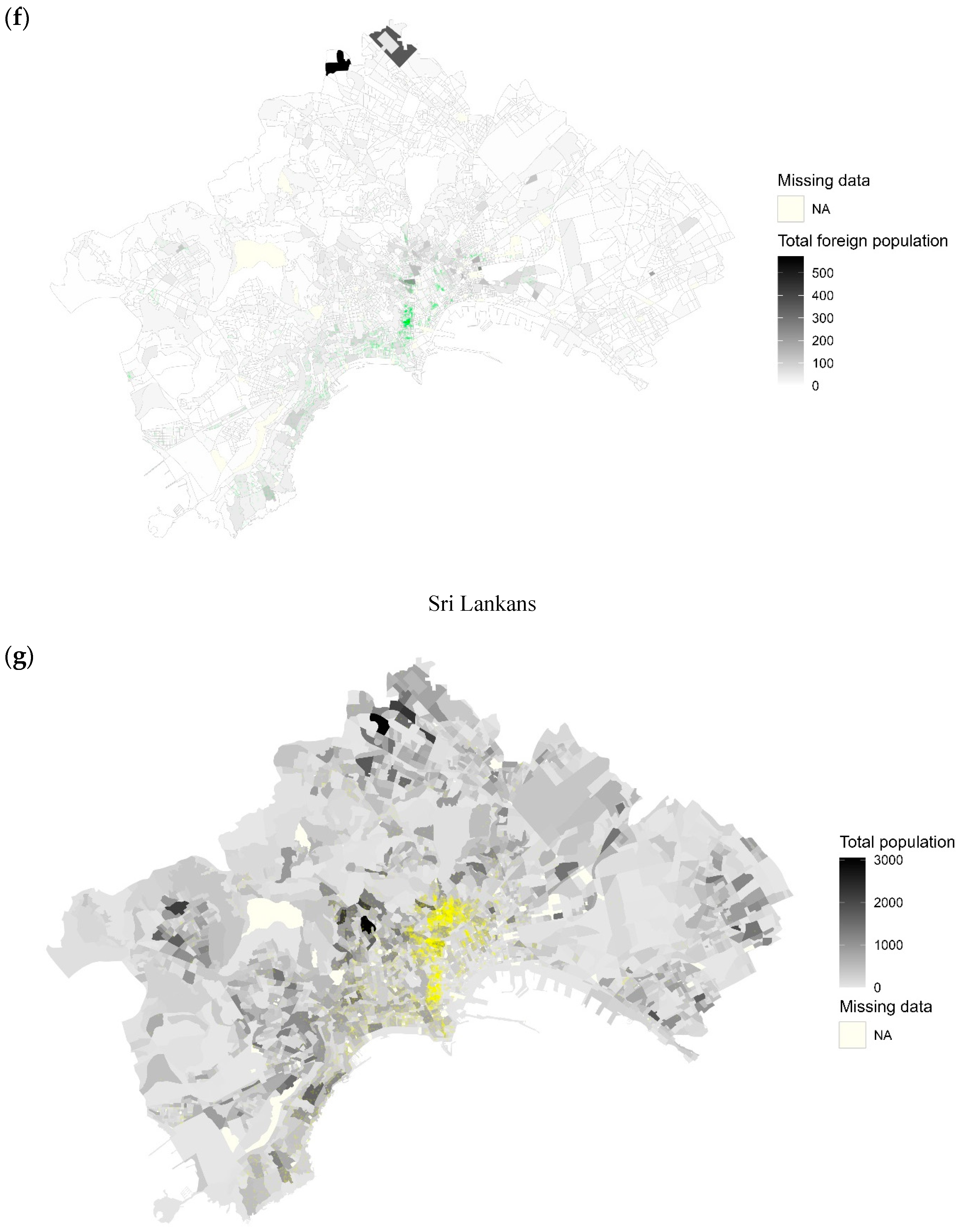
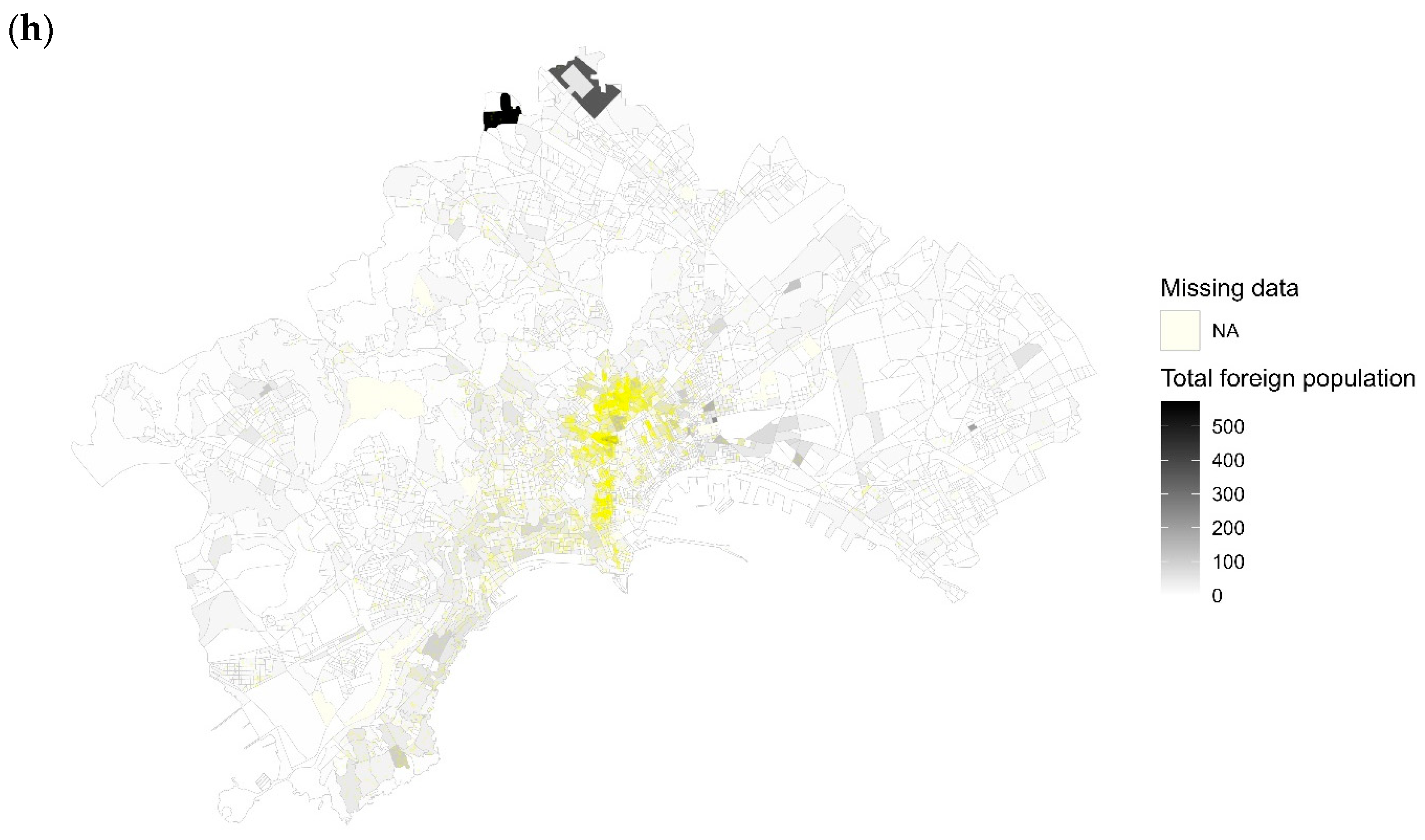
| 1 | World Bank data were retrieved from: https://data.worldbank.org/topic/urban-development (accessed on 27 June 2023). |
| 2 | Data on the selected immigrant groups did not include individuals who acquired Italian citizenship. |
| 3 | The Data for Integration (D4I) dataset, recently released by the European Commission’s Knowledge Centre on Migration and Demography, provides valuable information on migration patterns. This dataset was created by spatially disaggregating statistics from the 2011 Census, which were collected by national statistical institutes. Through this spatial processing, the original data were transformed into a uniform grid, revealing the distribution of migrants in cells measuring 100 by 100 m. This comprehensive dataset covers cities in eight European countries, namely, France, Germany, Ireland, Italy, the Netherlands, Portugal, Spain, and the United Kingdom. |
References
- Allasino, Enrico, Alessandra Venturini, and Giovanna Zincone. 2004. Labour Market Discrimination against Migrant Workers in Italy. Geneva: International Labour Organization. [Google Scholar]
- Allen, Judith, James Barlow, Jesus Leal, Thomas Maloutas, and Liliana Padovani. 2004. Housing and Welfare in Southern Europe. Oxford: Blackwell. [Google Scholar]
- Allport, Gordon. 1954. The Nature of Prejudice. Cambridge: Addison-Wesley. [Google Scholar]
- Ambrosini, Maurizio. 2013. Immigration in Italy: Between economic acceptance and political rejection. Journal of International Migration and Integration 14: 175–94. [Google Scholar] [CrossRef]
- Apparicio, Philippe. 2000. Les indices de ségrégation résidentielle: Un outil intégré dans un système d’information géographique. Cybergeo: European Journal of Geography 134. [Google Scholar] [CrossRef]
- Arapoglou, Vassilis P. 2012. Diversity, inequality and urban change. European Urban and Regional Studies 19: 223–37. [Google Scholar] [CrossRef]
- Arbaci, Sonia. 2004. Southern European multiethnic cities and the enduring housing crisis: Framing the urban and residential insertion of immigrants. Paper presented at ENHR Conference, Cambridge, UK, July 3. [Google Scholar]
- Arbaci, Sonia. 2007. The Residential Insertion of Immigrants in Europe: Patterns and Mechanisms in Southern European Cities. Ph.D. thesis, The Bartlett School of Planning—University College London, London, UK. [Google Scholar]
- Arbaci, Sonia. 2008. (Re)Viewing ethnic residential segregation in Southern European cities: Housing and urban regimes as mechanism 477 of marginalisation. Housing Studies 23: 589–613. [Google Scholar] [CrossRef]
- Bailey, Nick. 2012. How spatial segregation changes over time: Sorting out the sorting processes. Environment and Planning A: Economy and Space 44: 705–22. [Google Scholar] [CrossRef]
- Baldini, Massimo, and Marta Federici. 2011. Ethnic discrimination in the Italian rental housing market. Journal of Housing Economics 20: 1–14. [Google Scholar] [CrossRef]
- Bell, Wendell. 1954. A probability model for the measurement of ecological segregation. Social Forces 32: 357–64. [Google Scholar] [CrossRef]
- Benassi, Federico, Alessia Naccarato, Ricardo Iglesias-Pascual, Luca Salvati, and Salvatore Strozza. 2023a. Measuring residential segregation in multi-ethnic and unequal European cities. International Migration 61: 341–61. [Google Scholar] [CrossRef]
- Benassi, Federico, and Ricardo Iglesias-Pascual. 2022. Local-scale residential concentration and income inequalities of the main foreign-born population groups in the Spanish urban space. Reaffirming the model of a divided city. Journal of Ethnic and Migration Studies 49: 673–96. [Google Scholar] [CrossRef]
- Benassi, Federico, Corrado Bonifazi, Frank Heins, Fabio Lipizzi, and Salvatore Strozza. 2020a. Comparing Residential Segregation of Migrant Populations in Selected European Urban and Metropolitan Areas. Spatial Demography 8: 269–90. [Google Scholar] [CrossRef]
- Benassi, Federico, Fabio Lipizzi, and Salvatore Strozza. 2019. Detecting Foreigners’ Spatial Residential Patterns in Urban Contexts: Two Tales from Italy. Applied Spatial Analysis and Policy 12: 301–19. [Google Scholar] [CrossRef]
- Benassi, Federico, Francesca Bitonti, Angelo Mazza, and Salvatore Strozza. 2023b. Sri Lankans’ residential segregation and spatial inequalities in Southern Italy: An empirical analysis using fine-scale data on regular lattice geographies. Quality & Quantity 57: 1629–48. [Google Scholar] [CrossRef]
- Benassi, Federico, Ricardo Iglesias-Pascual, and Luca Salvati. 2020b. Residential segregation and social diversification: Exploring spatial settlement patterns of foreign population in Southern European cities. Habitat International 101: 102200. [Google Scholar] [CrossRef]
- Bitonti, Francesca, Aangelo Mazza, Massimo Mucciardi, and Luigi Scrofani. 2023. Urban transformations and the spatial distribution of foreign immigrants in Messina. In Models for Data Analysis: Paper presented at SIS Conference 2018, Palermo, Italy, June 20–22. Edited by Eugenio Brentari, Marcello Chiodi and Ernst-Jan Camiel Wit. Cham: Springer International Publishing, pp. 53–67. [Google Scholar]
- Blalock, Hubert M. 1967. Toward a Theory of Minority-Group Relations. New York: Wiley and Sons. [Google Scholar]
- Busetta, Annalisa, Angelo Mazza, and Manuela Stranges. 2015. Residential segregation of foreigners: An analysis of the Italian city of Palermo. Genus 491: 177–98. Available online: https://www.jstor.org/stable/genus.71.2-3.177 (accessed on 26 June 2023).
- Carella, Maria, and Roberta Pace. 2001. Some migration dynamics specifics to southern Europe: South-North and East-West Axis. International Migration 39: 63–99. [Google Scholar] [CrossRef]
- Caritas, Fondazione Zancan. 2011. Poveri di Diritti. Rapporto 2011 su Povertà ed Esclusione Sociale in Italia. Bologna: Il Mulino. [Google Scholar]
- Cesareo, Vincenzo, and Gian Carlo Blangiardo. 2009. Integration Indexes: Quaderni Ismu 2/2011. Milan: ISMU. [Google Scholar]
- Chang, Angela. 2012. 20th century Chinese migration to Italy: The Chinese diaspora presence within European international migration. History Compass 10: 179–90. [Google Scholar] [CrossRef]
- Clark, William A.V., and Mark Fossett. 2008. Understanding the social context of the Schelling segregation model. Proceedings of the National Academy of Sciences 105: 4109–14. [Google Scholar] [CrossRef] [PubMed]
- Costarelli, Igor, and Silvia Mugnano. 2017. Un’analisi della condizione abitativa degli stranieri a Roma e Milano: Micro-segregazione e periferizzazione. Fuori Luogo Rivista di Sociologia del Territorio Turismo Tecnologia 2: 39–47. [Google Scholar]
- Duncan, Otis Dudley, and Beverly Duncan. 1955. A methodological analysis of segregation indexes. American Sociological Review 20: 210–17. [Google Scholar] [CrossRef]
- Duncan, Otis Dudley, Ray P. Cuzzort, and Beverly Duncan. 1961. Statistical Geography: Problems in Analyzing Areal Data. Illinois: The Free Press of Glencoe. [Google Scholar]
- Farley, Reynolds. 1977. Residential segregation in urbanized areas of the United States in 1970: An analysis of social class and racial differences. Demography 14: 497–518. [Google Scholar] [CrossRef] [PubMed]
- Gelderblom, Derik, and Whynie Adams. 2006. The limits and possibilities of migrant networks. In Migration in South and Southern Africa: Dynamics and Determinants. Edited by John Oucho, Pieter Kok, Derik Gelderblom and Johan Van Zyl. Cape Town: HSRC Press, pp. 227–48. [Google Scholar]
- Goodchild, Michael F., Luc Anselin, and Uwe Deichmann. 1993. A Framework for the Areal Interpolation of Socioeconomic Data. Environment Planning A 25: 383–97. [Google Scholar] [CrossRef]
- Henayaka-Lochbihler, Ranjith, and Miriam Lambusta. 2004. The Sri Lankan Diaspora in Italy. Berlin and Heidelberg: Berghof Research Center for Conflict Management. [Google Scholar]
- Hewstone, Miles, and Rupert Brown. 1986. Contact Is Not Enough: An Intergroup Perspective on the ‘Contact Hypothesis’. In Contact and Conflict in Intergroup Encounters. Edited by Miles Hewstone and Rupert Brown. Oxford: Blackwell, pp. 1–44. [Google Scholar]
- Jost, Lou. 2010. The relation between evenness and diversity. Diversity 2: 207–32. [Google Scholar]
- Kauppinen, Timo M., and Maarten van Ham. 2019. Unravelling the demographic dynamics of ethnic residential segregation. Population Space and Place 25: e2193. [Google Scholar] [CrossRef] [PubMed]
- King, Russell. 2002. Toward a new map of European migration. International Journal of Population Geography 8: 89–106. [Google Scholar]
- King, Russell, ed. 1993. Mass Migration in Europe: The Legacy and the Future. London: Belhaven. [Google Scholar]
- Knights, Melanie. 1996. Bangladeshi Immigrants in Italy: From Geopolitics to Micropolitics. Transactions of the Institute of British Geographers 21: 105–23. [Google Scholar] [CrossRef]
- Kramer, Rory, and Peter Kramer. 2019. Diversifying but not integrating: Entropic measures of local segregation. Tijdschrift voor Economische en Sociale Geografie 110: 251–70. [Google Scholar] [CrossRef]
- Lieberson, Stanley. 1969. Measuring population diversity. American Sociological Review 34: 850–62. [Google Scholar] [CrossRef]
- Livi Bacci, Massimo. 2007. I grandi cicli migratori europei. Limes 4: 75–85. [Google Scholar]
- Logan, John R., and Charles Zhang. 2010. Global neighborhoods: New pathways to diversity and separation. American Journal of Sociology 115: 1069–109. [Google Scholar] [CrossRef]
- Malheiros, Jorge. 2002. Ethni-cities: Residential patterns in the Northern European and Mediterranean Metropolises- Implication for Policy Design. International Journal of Population Geography 8: 107–34. [Google Scholar] [CrossRef]
- Marcińczak, Szymon, Veronica Mooses, Magnus Strömgren, and Tiit Tammaru. 2021. A Comparative Study of Immigrant-Native Segregation at Multiple Spatial Scales in Urban Europe. Journal of Ethnic and Migration Studies 49: 43–65. [Google Scholar] [CrossRef]
- Massey, Douglas S., and Nancy A. Denton. 1988. The dimensions of residential segregation. Social Forces 67: 281–315. [Google Scholar] [CrossRef]
- Massey, Douglas S., and Nancy A. Denton. 1993. American Apartheid: Segregation and the Making of the Underclass. Cambridge: Harvard University Press. [Google Scholar]
- Mazza, Angelo, and Antonio Punzo. 2016. Spatial attraction in migrants’ settlement patterns in the city of Catania. Demographic Research 35: 117–38. [Google Scholar] [CrossRef]
- Mazza, Angelo, Giuseppe Gabrielli, and Salvatore Strozza. 2018. Residential segregation of foreign immigrants in Naples. Spatial Demography 6: 71–87. [Google Scholar] [CrossRef]
- Morgan, Barrie S. 1975. The segregation of socioeconomic groups in urban areas: A comparative analysis. Urban Studies 12: 47–60. [Google Scholar] [CrossRef]
- Mugnano, Silvia. 2017. Non Solo Housing. Qualità dell’Abitare in Italia nel Nuovo Millennio. Milan: FrancoAngeli. [Google Scholar]
- Musterd, Sako. 2005. Social and ethnic segregation in Europe: Levels, causes and effects. Journal of Urban Affairs 27: 331–48. [Google Scholar] [CrossRef]
- Musterd, Sako, and Arkaitz Fullaondo. 2008. Ethnic segregation and the housing market in two cities in northern and southern Europe: The cases of Amsterdam and Barcelona. ACE Arquitectura Ciudad y Entorno 3: 93–113. [Google Scholar] [CrossRef]
- Musterd, Sako, Szymon Marcińczak, Maarten van Ham, and Tiit Tammaru. 2015. Socio-Economic Segregation in European Capital Cities: Increasing Separation between Poor and Rich. Urban Geography 38: 1062–83. [Google Scholar] [CrossRef]
- OECD. 2018. Divided cities. In Understanding Intra-Urban Inequalities. Paris: OECD Publishing. [Google Scholar]
- Olteanu, Madalina, Cecile de Bezenac, William Clark, and Julien Randon-Furling. 2020. Revealing Multiscale Segregation Effects from Fine-Scale Data: A Case Study of Two Communities in Paris. Spatial Demography 8: 255–67. [Google Scholar] [CrossRef]
- Olteanu, Madalina, Julien Randon-Furling, and William A. Clark. 2019. Segregation through the multiscalar lens. Proceedings of the National Academy of Sciences 116: 12250–54. [Google Scholar] [CrossRef] [PubMed]
- Openshaw, Stan. 1984. Ecological Fallacies and the Analysis of Areal Census Data. Environment and Planning A 16: 17–31. [Google Scholar] [CrossRef] [PubMed]
- Openshaw, Stan, and Peter J. Taylor. 1979. A Million or so Correlation Coefficients: Three Experiments on the Modifiable Areal Unit Problem. In Statistical Applications in Spatial Sciences. Edited by Neil Wrigley. London: Pion, pp. 127–44. [Google Scholar]
- Panori, Anastasia, Yannis Psycharis, and Dimitris Ballas. 2019. Spatial segregation and migration in the city of Athens: Investigating the evolution of urban 481 socio-spatial immigrant structures. Population Space and Place 25: e2209. [Google Scholar] [CrossRef]
- Petsimeris, Petros, and Stefania Rimoldi. 2015. Socioeconomic divisions of space in Milan in the post-Fordist era. In Socioeconomic Segregation in European Capital Cities. East Meets West. Edited by Tiit Tammaru, Maarten van Ham, Szymon Marcińczak and Sako Musterd Abingdon. Oxon: Routledge, pp. 186–213. [Google Scholar]
- Piekut, Aneta, Gwilym Pryce, and Wouter van Gent. 2019. Segregation in the twenty first century: Processes, complexities and future directions. Tijdschrift Voor Economische En Sociale Geografie 110: 225–34. [Google Scholar] [CrossRef]
- Portes, Alejandro. 2000. Immigration and the metropolis: Reflections on urban history. Journal of International Migration and Integration 1: 153–75. [Google Scholar] [CrossRef]
- Prener, Christopher, and Charles Revord. 2019. Areal: An R Package for Areal Weighted Interpolation. Journal of Open Source Software 4: 1221. [Google Scholar] [CrossRef]
- Pugliese, Enrico. 2006. L’Italia Tra Migrazioni Internazionali e Migrazioni Interne. Bologna: Il Mulino. [Google Scholar]
- Putnam, Robert D. 2007. E Pluribus Unum: Diversity and Community in the Twenty-First Century: The 2006 Johan Skytte Prize Lecture. Scandinavian Political Studies 30: 137–74. [Google Scholar] [CrossRef]
- R Core Team. 2023. R: A Language and Environment for Statistical Computing. Vienna: R Foundation for Statistical Computing. Available online: https://www.R-project.org/ (accessed on 25 June 2023).
- Reardon, Sean F., and David O’Sullivan. 2004. Measures of spatial segregation. Sociological Methodology 34: 121–62. [Google Scholar] [CrossRef]
- Reardon, Sean F., and Glenn Firebaugh. 2002. Measures of multigroup segregation. Sociological Methodology 32: 33–67. [Google Scholar] [CrossRef]
- Rimoldi, Stefania M. L., and Laura Terzera. 2017. Neighbours and Friends? Can Residential Segregation Explain Ethnic Separation? The Case of Milan (Italy). Spatial Demography 5: 193–214. [Google Scholar] [CrossRef]
- Sakoda, James N. 1981. A generalized index of dissimilarity. Demography 18: 245–50. [Google Scholar] [CrossRef] [PubMed]
- Schelling, Thomas C. 1971. Dynamic models of segregation. Journal of Mathematical Sociology 1: 143–86. [Google Scholar] [CrossRef]
- Shannon, Claude Elwood. 1948. A mathematical theory of communication. The Bell System Technical Journal 27: 379–423. [Google Scholar] [CrossRef]
- Strozza, Salvatore. 2010. International migration in Europe in the first decade of the 21st century. Rivista Italiana di Economia Demografia e Statistica 64: 7–43. [Google Scholar]
- Strozza, Salvatore, Federico Benassi, Raffaele Ferrara, and Gerardo Gallo. 2016. Recent demographic trends in the major Italian urban agglomerations: The role of foreigners. Spatial Demography 4: 39–70. [Google Scholar] [CrossRef]
- Sturgis, Patrick, Ian Brunton-Smith, Jouni Kuha, and Jonathan Jackson. 2014. Ethnic diversity, segregation and the social cohesion of neighbourhoods in London. Ethnic and Racial Studies 37: 1286–309. [Google Scholar] [CrossRef]
- Tammaru, Tiit, Szymon Marcińczak, Maarten van Ham, and Sako Musterd. 2016. Socioeconomic Segregation in European Capital Cities: East Meets West (Regions and Cities). London: Routledge. [Google Scholar]
- Tammaru, Tiit, Szymon Marcińczak, Raivo Aunap, and Maarten van Ham. 2017. Inequalities and Segregation across the Long-Term Economic Cycle: An Analysis of South and North European Cities. Bonn: Institute of Labor Economics (IZA), p. 10980. [Google Scholar]
- Theil, Henri. 1972. Statistical Decomposition Analysis. Amsterdam: North-Holland. [Google Scholar]
- Theil, Henri, and Anthony J. Finizza. 1971. A Note on the measurement of racial integration of schools by means of informational concepts. Journal of Mathematical Sociology 1: 187–93. [Google Scholar] [CrossRef]
- Tivadar, Mihai. 2019. OasisR: An R package to bring some order to the world of segregation measurement. Journal of Statistical Software 89: 1–39. [Google Scholar] [CrossRef]
- van Ham, Maarten, Tiit Tammaru, Rūta Ubarevičienė, and Heleen Janssen. 2021. Urban Socio-Economic Segregation and Income Inequality: A Global Perspective. Berlin and Heidelberg: Springer. [Google Scholar]
- Van Kempen, Ronald, and A. Şule Özüekren. 1998. Ethnic segregation in cities: New forms and explanations in a dynamic world. Urban Studies 35: 1631–56. [Google Scholar] [CrossRef]
- Vertovec, Steven. 2007. Super-diversity and its implications. Ethnic and Racial Studies 30: 1024–54. [Google Scholar] [CrossRef]
- Wacquant, Loïc. 2007. Urban Outcasts: A Comparative Sociology of Advanced Marginality. Cambridge: Polity Press. [Google Scholar]
- Wessel, Terje, Lena Magnusson Turner, and Viggo Nordvik. 2018. Population dynamics and ethnic geographies in Oslo: The impact of migration and natural demographic change on ethnic composition and segregation. Journal of Housing and the Built Environment 33: 789–805. [Google Scholar] [CrossRef]
- Wessendorf, Susanne. 2014. ‘Being open, but sometimes closed’. Conviviality in a super-diverse London neighbourhood. European Journal of Cultural Studies 17: 392–405. [Google Scholar] [CrossRef]
- White, Michael J. 1986. Segregation and diversity measures in population distribution. Population Index 52: 198–221. [Google Scholar] [CrossRef] [PubMed]
- Yao, Jing, David W. Wong, Nick Bailey, and Jonathan Minton. 2019. Spatial segregation measures: A methodological review. Tijdschrift voor Economische en Sociale Geografie 110: 235–50. [Google Scholar] [CrossRef]
- Zwiers, Merle, Maarten van Ham, and David Manley. 2017. Trajectories of ethnic neighbourhood change: Spatial patterns of increasing ethnic diversity. Population, Space and Place 24: e2094. [Google Scholar] [CrossRef]
| Value/Year | BGD | CHN | PHL | LKA | Total Immigrants |
|---|---|---|---|---|---|
| Milan | |||||
| Absolute values | |||||
| 2001 | 769 | 5556 | 14,673 | 4889 | 87,590 |
| 2011 | 3740 | 19,795 | 33,214 | 11,440 | 198,813 |
| 2021 | 10,328 | 30,688 | 37,540 | 15,503 | 253,531 |
| % of immigrants in the city | |||||
| 2001 | 0.9 | 6.3 | 16.8 | 5.6 | 29.6 |
| 2011 | 1.9 | 10.0 | 16.7 | 5.7 | 34.3 |
| 2021 | 4.1 | 12.1 | 14.8 | 6.1 | 37.1 |
| % of the nationality in Italy | |||||
| 2001 | 5.2 | 11.8 | 27.2 | 18.5 | 6.6 |
| 2011 | 4.5 | 9.9 | 24.6 | 15.5 | 4.9 |
| 2021 | 6.5 | 10.2 | 23.6 | 14.3 | 5.0 |
| Rome | |||||
| Absolute values | |||||
| 2001 | 3124 | 2903 | 13,105 | 2296 | 98,427 |
| 2011 | 17,841 | 12,096 | 28,410 | 5228 | 260,171 |
| 2021 | 32,963 | 17,244 | 38,484 | 8719 | 338,548 |
| % of immigrants in the city | |||||
| 2001 | 3.2 | 2.9 | 13.3 | 2.3 | 21.8 |
| 2011 | 6.9 | 4.6 | 10.9 | 2.0 | 24.4 |
| 2021 | 9.7 | 5.1 | 11.4 | 2.6 | 28.8 |
| % of the nationality in Italy | |||||
| 2001 | 21.3 | 6.2 | 24.3 | 8.7 | 7.4 |
| 2011 | 21.7 | 6.1 | 21.0 | 7.1 | 6.5 |
| 2021 | 20.7 | 5.7 | 24.2 | 8.1 | 6.7 |
| Naples | |||||
| Absolute values | |||||
| 2001 | 14 | 285 | 480 | 1496 | 8757 |
| 2011 | 461 | 2636 | 1587 | 7238 | 35,580 |
| 2021 | 1960 | 4412 | 1708 | 14,291 | 53,440 |
| % of immigrants in the city | |||||
| 2001 | 0.2 | 3.3 | 5.5 | 17.1 | 26.0 |
| 2011 | 1.3 | 7.4 | 4.5 | 20.3 | 33.5 |
| 2021 | 3.7 | 8.3 | 3.2 | 26.7 | 41.9 |
| % of the nationality in Italy | |||||
| 2001 | 0.1 | 0.6 | 0.9 | 5.7 | 0.7 |
| 2011 | 0.6 | 1.3 | 1.2 | 9.8 | 0.9 |
| 2021 | 1.2 | 1.5 | 1.1 | 13.2 | 1.1 |
| Segregation Indices | Milan | |||
|---|---|---|---|---|
| BGD | CHN | PHL | LKA | |
| Duncan’s dissimilarity (ref. group: Italians) | 0.7897 | 0.6067 | 0.4214 | 0.4887 |
| Multi-group Duncan’s dissimilarity | 0.4777 | |||
| Multi-group Duncan’s dissimilarity (including Italians) | 0.4566 | |||
| Delta | 0.8423 | 0.6788 | 0.5435 | 0.5904 |
| Bell’s isolation (ref. group: Italians) | 0.0612 | 0.0996 | 0.0757 | 0.0361 |
| Theil’s entropy (ref. group: Italians) | 0.3284 | 0.2451 | 0.1291 | 0.1435 |
| Multi-group Theil’s entropy | 0.2944 | |||
| Multi-group Theil’s entropy (including Italians) | 0.176 | |||
| Segregation Indices | Rome | |||
| BGD | CHN | PHL | LKA | |
| Duncan’s dissimilarity (ref. group: Italians) | 0.7151 | 0.6989 | 0.5172 | 0.7308 |
| Multi-group Duncan’s dissimilarity | 0.6521 | |||
| Multi-group Duncan’s dissimilarity (including Italians) | 0.5467 | |||
| Delta | 0.8673 | 0.8493 | 0.7130 | 0.7912 |
| Bell’s isolation (ref. group: Italians) | 0.2203 | 0.074 | 0.0455 | 0.0302 |
| Theil’s entropy (ref. group: Italians) | 0.3812 | 0.2895 | 0.1628 | 0.2598 |
| Multi-group Theil’s entropy | 0.4955 | |||
| Multi-group Theil’s entropy (including Italians) | 0.2559 | |||
| Segregation Indices | Naples | |||
| BGD | CHN | PHL | LKA | |
| Duncan’s dissimilarity (ref. group: Italians) | 0.9444 | 0.9042 | 0.7972 | 0.6765 |
| Multi-group Duncan’s dissimilarity | 0.7837 | |||
| Multi-group Duncan’s dissimilarity (including Italians) | 0.7086 | |||
| Delta | 0.9662 | 0.8814 | 0.7669 | 0.6958 |
| Bell’s isolation (ref. group: Italians) | 0.0466 | 0.1605 | 0.0257 | 0.0525 |
| Theil’s entropy (ref. group: Italians) | 0.4567 | 0.5087 | 0.2891 | 0.2523 |
| Multi-group Theil’s entropy | 0.6636 | |||
| Multi-group Theil’s entropy (including Italians) | 0.3287 | |||
| Segregation Indices | LKA—BGD | LKA—CHN | LKA—PHL | LKA—ITA | BGD—CHN | BGD—PHL | BGD—ITA | CHN—PHL | CHN—ITA | PHL—ITA |
|---|---|---|---|---|---|---|---|---|---|---|
| Milan | ||||||||||
| Duncan’s dissimilarity | 0.7244 | 0.602 | 0.4439 | 0.489 | 0.6746 | 0.6941 | 0.79 | 0.539 | 0.607 | 0.421 |
| Theil’s entropy | 0.5353 | 0.426 | 0.231 | 0.144 | 0.4492 | 0.4196 | 0.328 | 0.3334 | 0.245 | 0.129 |
| Bell’s isolation | 0.8855 | 0.663 | 0.4367 | 0.036 | 0.5103 | 0.4033 | 0.061 | 0.6066 | 0.1 | 0.076 |
| Shannon–Wiener diversity | 0.5583 | 0.657 | 0.569 | 0.06 | 0.4379 | 0.3277 | 0.024 | 0.6608 | 0.093 | 0.138 |
| Segregation Indices | Rome | |||||||||
| Duncan’s dissimilarity | 0.8431 | 0.851 | 0.6603 | 0.731 | 0.5796 | 0.7445 | 0.715 | 0.767 | 0.699 | 0.517 |
| Theil’s entropy | 0.9062 | 0.931 | 0.7096 | 0.763 | 0.5643 | 0.7987 | 0.77 | 0.819 | 0.732 | 0.459 |
| Bell’s isolation | 0.7446 | 0.774 | 0.4603 | 0.26 | 0.3901 | 0.6012 | 0.381 | 0.6118 | 0.29 | 0.163 |
| Shannon–Wiener diversity | 0.8217 | 0.857 | 0.5241 | 0.03 | 0.7711 | 0.7756 | 0.22 | 0.7443 | 0.074 | 0.046 |
| Segregation Indices | Naples | |||||||||
| Duncan’s dissimilarity | 0.9244 | 0.931 | 0.6567 | 0.677 | 0.7677 | 0.9244 | 0.944 | 0.9136 | 0.904 | 0.797 |
| Theil’s entropy | 0.9705 | 0.971 | 0.6673 | 0.667 | 0.8048 | 0.9791 | 0.967 | 0.9696 | 0.942 | 0.828 |
| Bell’s isolation | 0.8174 | 0.864 | 0.4311 | 0.252 | 0.5828 | 0.8772 | 0.457 | 0.8564 | 0.509 | 0.289 |
| Shannon–Wiener diversity | 0.9872 | 0.969 | 0.8942 | 0.053 | 0.6411 | 0.9136 | 0.047 | 0.953 | 0.161 | 0.026 |
Disclaimer/Publisher’s Note: The statements, opinions and data contained in all publications are solely those of the individual author(s) and contributor(s) and not of MDPI and/or the editor(s). MDPI and/or the editor(s) disclaim responsibility for any injury to people or property resulting from any ideas, methods, instructions or products referred to in the content. |
© 2023 by the authors. Licensee MDPI, Basel, Switzerland. This article is an open access article distributed under the terms and conditions of the Creative Commons Attribution (CC BY) license (https://creativecommons.org/licenses/by/4.0/).
Share and Cite
Bitonti, F.; Benassi, F.; Mazza, A.; Strozza, S. Framing the Residential Patterns of Asian Communities in Three Italian Cities: Evidence from Milan, Rome, and Naples. Soc. Sci. 2023, 12, 480. https://doi.org/10.3390/socsci12090480
Bitonti F, Benassi F, Mazza A, Strozza S. Framing the Residential Patterns of Asian Communities in Three Italian Cities: Evidence from Milan, Rome, and Naples. Social Sciences. 2023; 12(9):480. https://doi.org/10.3390/socsci12090480
Chicago/Turabian StyleBitonti, Francesca, Federico Benassi, Angelo Mazza, and Salvatore Strozza. 2023. "Framing the Residential Patterns of Asian Communities in Three Italian Cities: Evidence from Milan, Rome, and Naples" Social Sciences 12, no. 9: 480. https://doi.org/10.3390/socsci12090480





